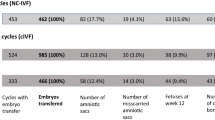Abstract
Purpose: Our purpose was to determine if pregnancy rates(PRs) for hMG (human menopausalgonadotropin)-stimulated IVF-ET (in vitro ferilization-embryo transfer) can beincreased by estradiol (E2) supplementation from the earlyproliferative phase to the late secretory phase of theendometrium.
Method: Eighty-one infertile women with pure tubal factorwere randomized into two groups. One group received noE2 supplementation (control group) and the other receivedoral E2 supplementation (2 mg two times daily) from theearly proliferative phase starting on the third day of themenstrual cycle to the late secretory phase of theendometrium, with hMG stimulation for ovulation induction startingon the sixth day of the menstrual cycle.
Results: In 85 cycles, at least one embryo was transferred.Compared with the control group (n = 27 cycles), the E2supplementation group (n = 58 cycles) had a significantlyhigher PR (control, 25.9%, versus E2 supplementation,48.3%) and IR per ET (control, 10%, versus E2supplementation, 26%), but FRs per retrieved oocytes were notstatistically different between the two groups (control, 74%, versusE2 supplementation group, 73%). Four spontaneousabortions occurred in the E2 supplementation group, and onecase in the control group. Ectopic pregnancy occurred inone case in the control group.
Conclusions: Clinical PRs and IRs in the E2supplementation group were significantly higher than in the controlgroup, while FRs in the control group did not differstatistically from the E2 supplementation group. This suggests thatE2 supplementation from the early proliferative phase to thelate secretory phase of the endometrium in hMG-stimulatedIVF-ET increases the receptivity of the endometrium fortransferred embryos and clinical PRs.
Similar content being viewed by others
REFERENCES
Edwards RG: Clinical approaches to increasing uterine receptivity during human implantation. Hum Reprod 1995;10 (Suppl 2):60-66
Lewin A, Benshushan A, Mezker E, Yanai N, Schenker JG, Goshen R: The role of estrogen support during luteal phase of in vitro fertilization-embryo transplant cycles: A comparative study between progesterone alone and estrogen and progesterone support. Fertil Steril 1994;62(1):121-125
Buttram VC, Turati G: Uterine synechiae: Variations in severity and some conditions which may be conducive to severe adhesions. Int J Fertil 1977;22:98-103
Katzenellenbogen BS: Dynamics of steroid hormone receptor action. Annu Rev Physiol 1980;42:17-35
Gonen Y, Casper RF, Jacobson W, Blankier J: Endometrial thickness and growth during ovarian stimulation: A possible predictor of implantation in in vitro fertilization. Fertil Steril 1989; 52(3):446-450
Gonen Y, Calderon M, Dirnfeld M, Abramovici H: The impact of sonographic assessment of the endometrium and meticulous hormonal monitoring during natural cycles in patients with failed donor artificial insemination. Ultrasound Obstet Gynecol 1991;1:122-126
Glissant A, de Mouzoun J, Frydman R: Ultrasound study of the endometrium during in vitro fertilization cycles. Fertil Steril 1985;44:786-790
Gonen Y, Casper RF: Prediction of implantation by the sonographic appearance of the endometrium during controlled ovarian stimulation for in vitro fertilization (IVF) J Vitro Fert Embryo Transfer 1990;7:146-152
Gonen Y, Casper RF, Jacobson W, Blankier J: Endometrial thickness and growth during ovarian stimulation: A possible predictor of implantation in in vitro ferilization. Fertil Steril 1989;52:446-450
Fleischer AC, Herbert CM, Sacks GA, Wentz AC, Entman SS, James AE: Sonography of the endometrium during conception and non conception cycles of in vitro fertilization and embryo transfer. Fertil Steril 1986;46;442-447
Ueno J, Oehninger S, Brzyski RG, Ascsta AA, Phiput B, Muasber SJ: Ultrasonographic appearance of the endometrium in natural and stimulation in-vitro fertilization cycles and its corration with outcome. Hum Reprod 1991;6:901-904
Check JH, Nowroozi K, Choe J, Dietterich C: Influence of endometrial thickness and echo patterns on pregnanacy rates during in vitro fertilization. Fertil Steril 1991;56(6):1173-1175
Ghosh D, Sengupta J: Another look at the issue of periimplantation oestrogen. Hum Reprod 1995;10:1-7
Smitz J, Bourgain C, Van Waesberghe L, Camus M, Devroey P, Van Steirteghem AC: A prospective randomized study on oestradiol valerate supplementation in addition to intravaginal micronized progesterone in buserelin and HMG induced super-ovulation. Hum Reprod 1993;8:40-45
Rosenwaks Z: Donor eggs: Their application in modern reproductive technologies. Fertil Steril 1987;47:895-909
Hutchinson-Williams KA, DeCherney AH, Lavy G, Kiamond MP, Naftolin F, Lunenfeld B: Luteal rescus in in vitro fertilization-embryo transfer. Fertil Steril 1990;53:485-501
Hutchinson-Williams KA, Lunenfeld B, Kiamond MP, Lavy G, Bouert SP, DeCherney AH: Human chorionic gonadotropin, estradiol and progesterone profiles in conception and nonconception cycles in an in vitro fertilization program. Fertil Steril 1989;52:441-445
Yovich JL, Stanger JD, Yovich JM, Tuvik AI, Tuznex SR: Hormonal profiles in the follicular phase, luteal phase and first trimester of pregnancies arising from in vitro fertilization. Br J Obstet Gynecol 1985;92:374-384
Lejeune B, Camus M, Deachacht J, Leroy F: Differences in the luteal phase after failed or successful in vitro fertilizatiion and embryo replacement. J Vitro Fert Embryo Transfer 1988;3:358-386
Nylund L, Beskow C, Carlstrom K, Fredriceon B, Quatsfson O, Luncil NO: The early luteal phase in successful and unsuccessful implantation after IVF-ET. Hum Reprod 1990;5:40-42
Wang L, Warnes GM, Kirby CA, Matthews CD, Norman RJ: Luteal function associated with single, multiple and ectopic embryo implantation in natural cycles or after ovarian hyperstimulation for in vitro fertilization/gamete intrafallopian transfer. Hum Reprod 1990;5:476-480
Author information
Authors and Affiliations
Rights and permissions
About this article
Cite this article
Jung, >., Roh, H.K. The Effects of E2 Supplementation from the Early Proliferative Phase to the Late Secretory Phase of the Endometrium in hMG-Stimulated IVF-ET. J Assist Reprod Genet 17, 28–33 (2000). https://doi.org/10.1023/A:1009445913156
Issue Date:
DOI: https://doi.org/10.1023/A:1009445913156



